Analyzing the Legal System in Canada: The Case of Same-Sex Marriage
VerifiedAdded on 2020/05/01
|6
|1101
|161
AI Summary
The case, Reference re Same-Sex Marriage 2004 SCC 79, addresses the proposed federal legislation recognizing same-sex marriages in Canada. The Supreme Court analyzed whether this proposal fell within federal jurisdiction under s.91(26) or provincial jurisdiction per s.92(12) of the Constitution Act, 1867, employing the doctrine of pith and substance for its analysis. The court ruled that defining marriage as a union between two individuals was within federal power but extending beyond this definition in legislation was not. Additionally, it found such definitions consistent with the Charter of Rights and Freedoms, reinforcing religious officials' freedom under section 2(a). This decision affirmed same-sex marriage's constitutional recognition while respecting existing religious freedoms, emphasizing the nuanced interplay of Canadian constitutional provisions.
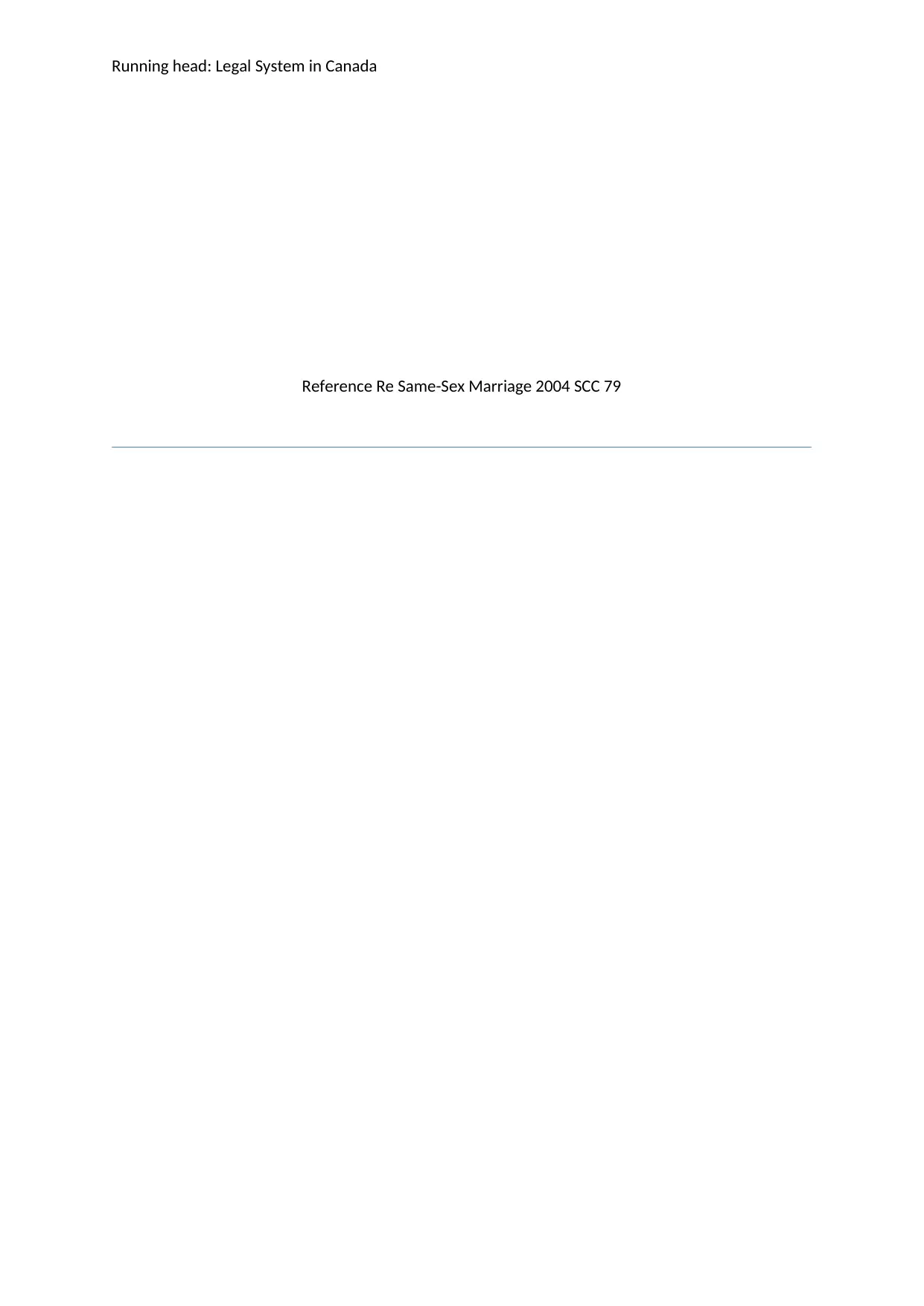
Running head: Legal System in Canada
Reference Re Same-Sex Marriage 2004 SCC 79
Reference Re Same-Sex Marriage 2004 SCC 79
Paraphrase This Document
Need a fresh take? Get an instant paraphrase of this document with our AI Paraphraser
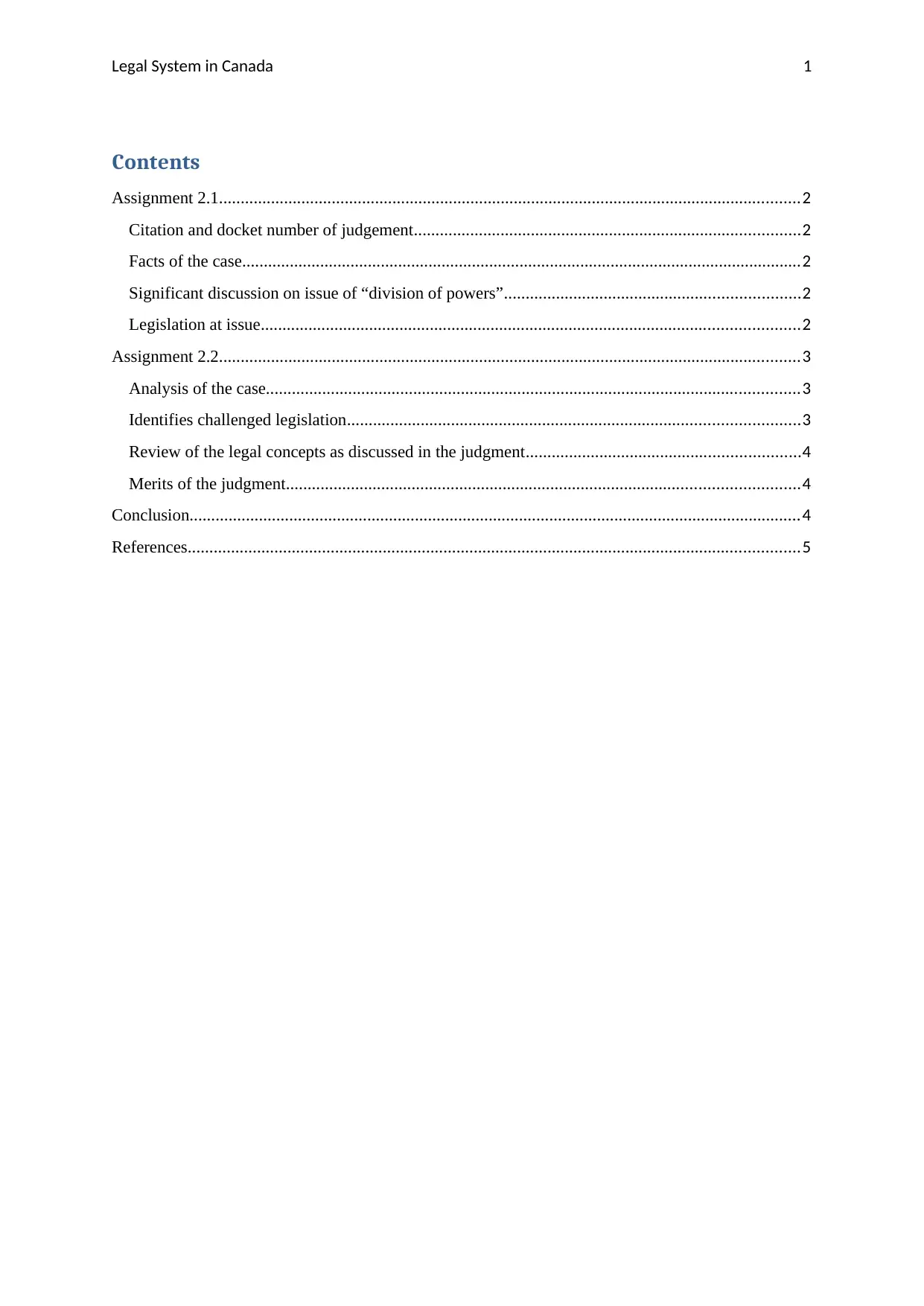
Legal System in Canada 1
Contents
Assignment 2.1......................................................................................................................................2
Citation and docket number of judgement.........................................................................................2
Facts of the case.................................................................................................................................2
Significant discussion on issue of “division of powers”....................................................................2
Legislation at issue............................................................................................................................2
Assignment 2.2......................................................................................................................................3
Analysis of the case...........................................................................................................................3
Identifies challenged legislation........................................................................................................3
Review of the legal concepts as discussed in the judgment...............................................................4
Merits of the judgment......................................................................................................................4
Conclusion.............................................................................................................................................4
References.............................................................................................................................................5
Contents
Assignment 2.1......................................................................................................................................2
Citation and docket number of judgement.........................................................................................2
Facts of the case.................................................................................................................................2
Significant discussion on issue of “division of powers”....................................................................2
Legislation at issue............................................................................................................................2
Assignment 2.2......................................................................................................................................3
Analysis of the case...........................................................................................................................3
Identifies challenged legislation........................................................................................................3
Review of the legal concepts as discussed in the judgment...............................................................4
Merits of the judgment......................................................................................................................4
Conclusion.............................................................................................................................................4
References.............................................................................................................................................5
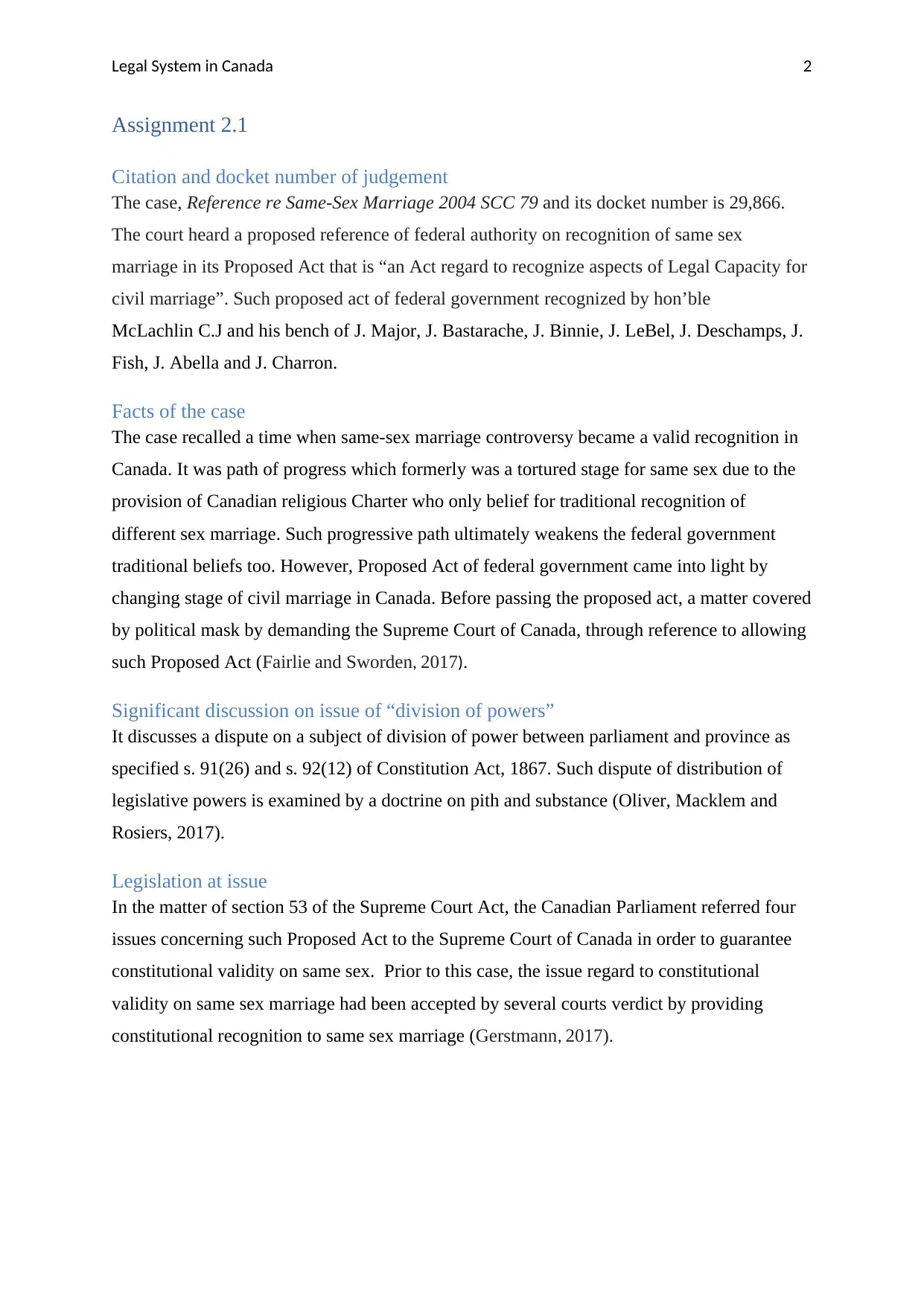
Legal System in Canada 2
Assignment 2.1
Citation and docket number of judgement
The case, Reference re Same-Sex Marriage 2004 SCC 79 and its docket number is 29,866.
The court heard a proposed reference of federal authority on recognition of same sex
marriage in its Proposed Act that is “an Act regard to recognize aspects of Legal Capacity for
civil marriage”. Such proposed act of federal government recognized by hon’ble
McLachlin C.J and his bench of J. Major, J. Bastarache, J. Binnie, J. LeBel, J. Deschamps, J.
Fish, J. Abella and J. Charron.
Facts of the case
The case recalled a time when same-sex marriage controversy became a valid recognition in
Canada. It was path of progress which formerly was a tortured stage for same sex due to the
provision of Canadian religious Charter who only belief for traditional recognition of
different sex marriage. Such progressive path ultimately weakens the federal government
traditional beliefs too. However, Proposed Act of federal government came into light by
changing stage of civil marriage in Canada. Before passing the proposed act, a matter covered
by political mask by demanding the Supreme Court of Canada, through reference to allowing
such Proposed Act (Fairlie and Sworden, 2017).
Significant discussion on issue of “division of powers”
It discusses a dispute on a subject of division of power between parliament and province as
specified s. 91(26) and s. 92(12) of Constitution Act, 1867. Such dispute of distribution of
legislative powers is examined by a doctrine on pith and substance (Oliver, Macklem and
Rosiers, 2017).
Legislation at issue
In the matter of section 53 of the Supreme Court Act, the Canadian Parliament referred four
issues concerning such Proposed Act to the Supreme Court of Canada in order to guarantee
constitutional validity on same sex. Prior to this case, the issue regard to constitutional
validity on same sex marriage had been accepted by several courts verdict by providing
constitutional recognition to same sex marriage (Gerstmann, 2017).
Assignment 2.1
Citation and docket number of judgement
The case, Reference re Same-Sex Marriage 2004 SCC 79 and its docket number is 29,866.
The court heard a proposed reference of federal authority on recognition of same sex
marriage in its Proposed Act that is “an Act regard to recognize aspects of Legal Capacity for
civil marriage”. Such proposed act of federal government recognized by hon’ble
McLachlin C.J and his bench of J. Major, J. Bastarache, J. Binnie, J. LeBel, J. Deschamps, J.
Fish, J. Abella and J. Charron.
Facts of the case
The case recalled a time when same-sex marriage controversy became a valid recognition in
Canada. It was path of progress which formerly was a tortured stage for same sex due to the
provision of Canadian religious Charter who only belief for traditional recognition of
different sex marriage. Such progressive path ultimately weakens the federal government
traditional beliefs too. However, Proposed Act of federal government came into light by
changing stage of civil marriage in Canada. Before passing the proposed act, a matter covered
by political mask by demanding the Supreme Court of Canada, through reference to allowing
such Proposed Act (Fairlie and Sworden, 2017).
Significant discussion on issue of “division of powers”
It discusses a dispute on a subject of division of power between parliament and province as
specified s. 91(26) and s. 92(12) of Constitution Act, 1867. Such dispute of distribution of
legislative powers is examined by a doctrine on pith and substance (Oliver, Macklem and
Rosiers, 2017).
Legislation at issue
In the matter of section 53 of the Supreme Court Act, the Canadian Parliament referred four
issues concerning such Proposed Act to the Supreme Court of Canada in order to guarantee
constitutional validity on same sex. Prior to this case, the issue regard to constitutional
validity on same sex marriage had been accepted by several courts verdict by providing
constitutional recognition to same sex marriage (Gerstmann, 2017).
⊘ This is a preview!⊘
Do you want full access?
Subscribe today to unlock all pages.

Trusted by 1+ million students worldwide
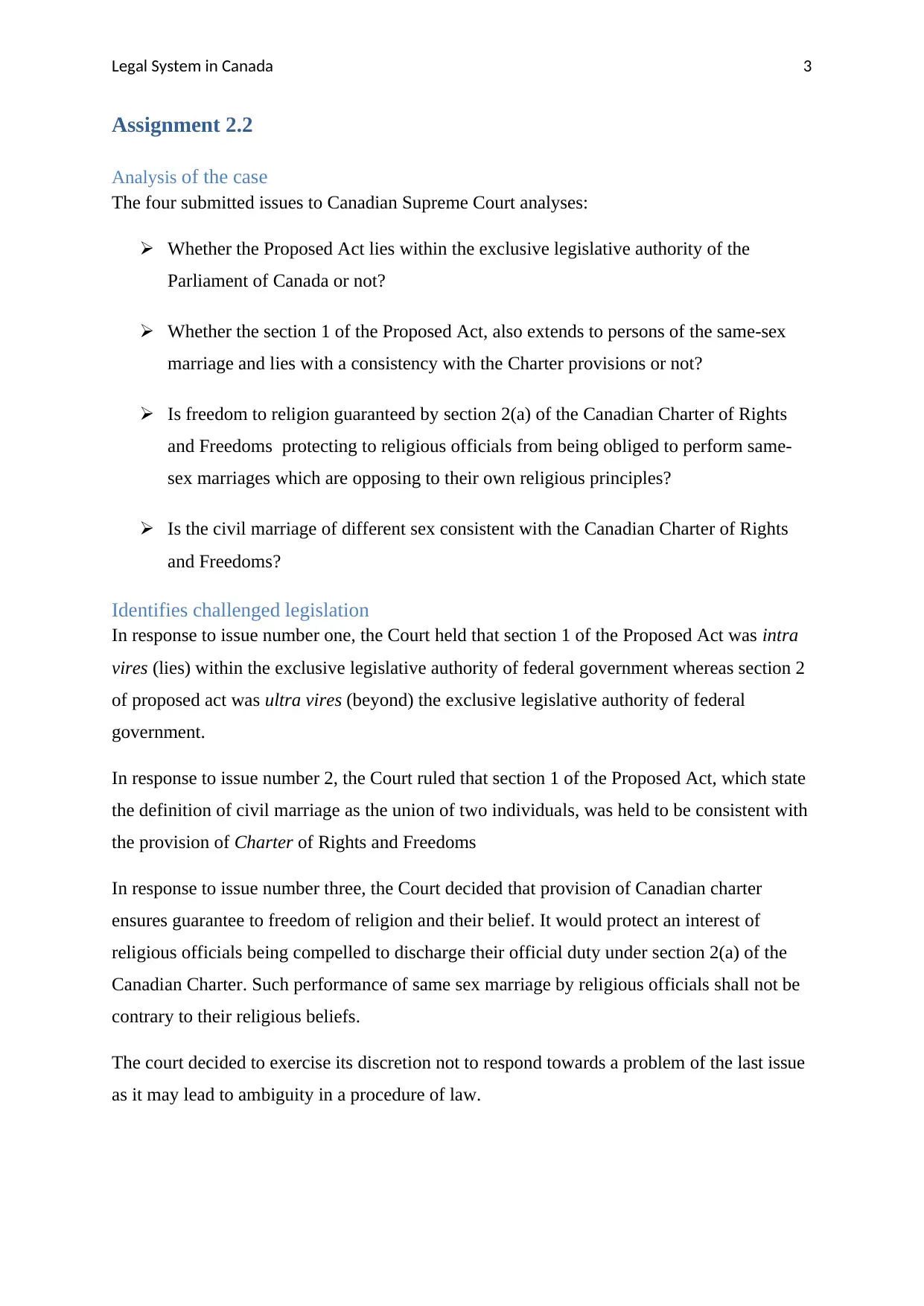
Legal System in Canada 3
Assignment 2.2
Analysis of the case
The four submitted issues to Canadian Supreme Court analyses:
Whether the Proposed Act lies within the exclusive legislative authority of the
Parliament of Canada or not?
Whether the section 1 of the Proposed Act, also extends to persons of the same-sex
marriage and lies with a consistency with the Charter provisions or not?
Is freedom to religion guaranteed by section 2(a) of the Canadian Charter of Rights
and Freedoms protecting to religious officials from being obliged to perform same-
sex marriages which are opposing to their own religious principles?
Is the civil marriage of different sex consistent with the Canadian Charter of Rights
and Freedoms?
Identifies challenged legislation
In response to issue number one, the Court held that section 1 of the Proposed Act was intra
vires (lies) within the exclusive legislative authority of federal government whereas section 2
of proposed act was ultra vires (beyond) the exclusive legislative authority of federal
government.
In response to issue number 2, the Court ruled that section 1 of the Proposed Act, which state
the definition of civil marriage as the union of two individuals, was held to be consistent with
the provision of Charter of Rights and Freedoms
In response to issue number three, the Court decided that provision of Canadian charter
ensures guarantee to freedom of religion and their belief. It would protect an interest of
religious officials being compelled to discharge their official duty under section 2(a) of the
Canadian Charter. Such performance of same sex marriage by religious officials shall not be
contrary to their religious beliefs.
The court decided to exercise its discretion not to respond towards a problem of the last issue
as it may lead to ambiguity in a procedure of law.
Assignment 2.2
Analysis of the case
The four submitted issues to Canadian Supreme Court analyses:
Whether the Proposed Act lies within the exclusive legislative authority of the
Parliament of Canada or not?
Whether the section 1 of the Proposed Act, also extends to persons of the same-sex
marriage and lies with a consistency with the Charter provisions or not?
Is freedom to religion guaranteed by section 2(a) of the Canadian Charter of Rights
and Freedoms protecting to religious officials from being obliged to perform same-
sex marriages which are opposing to their own religious principles?
Is the civil marriage of different sex consistent with the Canadian Charter of Rights
and Freedoms?
Identifies challenged legislation
In response to issue number one, the Court held that section 1 of the Proposed Act was intra
vires (lies) within the exclusive legislative authority of federal government whereas section 2
of proposed act was ultra vires (beyond) the exclusive legislative authority of federal
government.
In response to issue number 2, the Court ruled that section 1 of the Proposed Act, which state
the definition of civil marriage as the union of two individuals, was held to be consistent with
the provision of Charter of Rights and Freedoms
In response to issue number three, the Court decided that provision of Canadian charter
ensures guarantee to freedom of religion and their belief. It would protect an interest of
religious officials being compelled to discharge their official duty under section 2(a) of the
Canadian Charter. Such performance of same sex marriage by religious officials shall not be
contrary to their religious beliefs.
The court decided to exercise its discretion not to respond towards a problem of the last issue
as it may lead to ambiguity in a procedure of law.
Paraphrase This Document
Need a fresh take? Get an instant paraphrase of this document with our AI Paraphraser
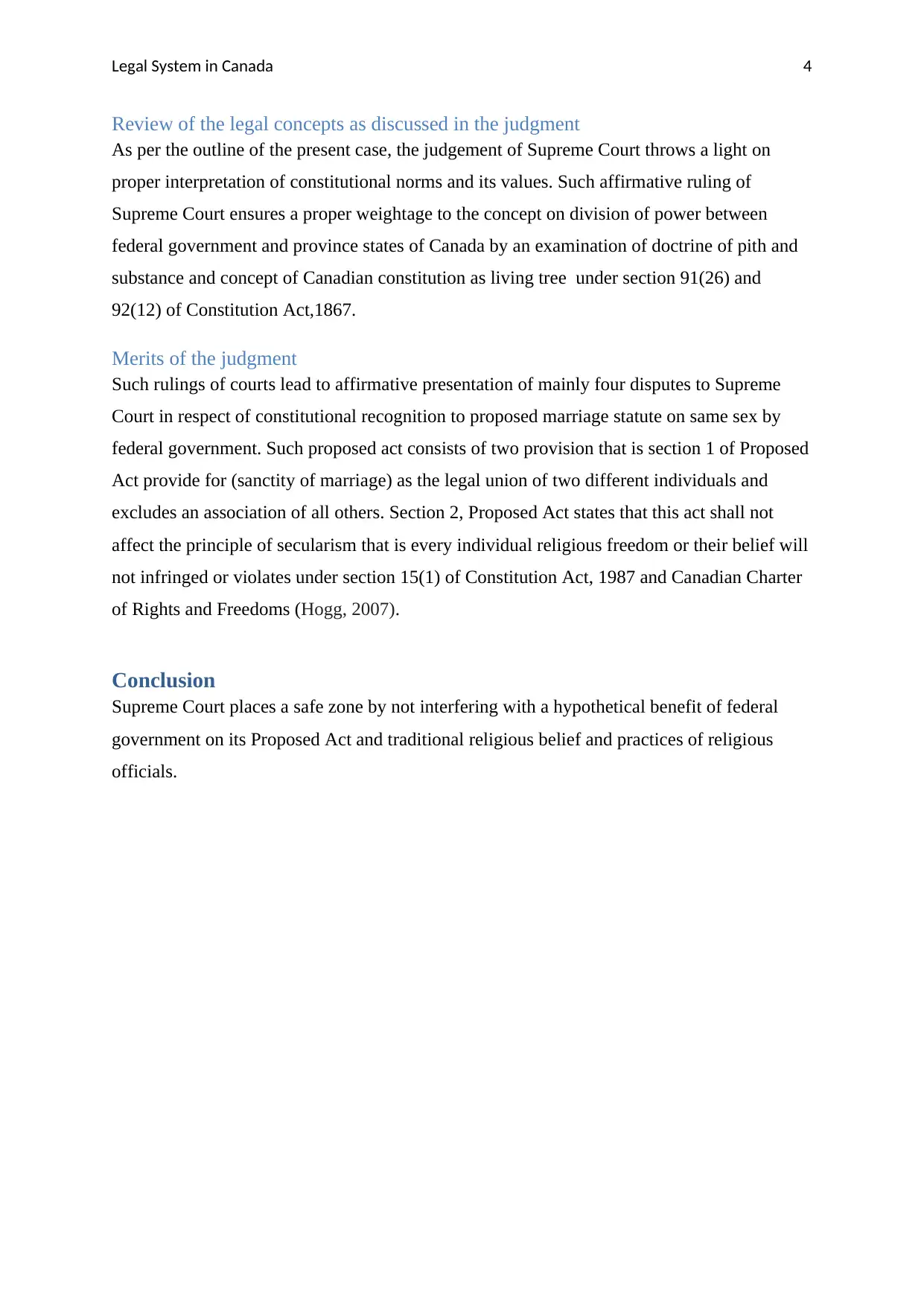
Legal System in Canada 4
Review of the legal concepts as discussed in the judgment
As per the outline of the present case, the judgement of Supreme Court throws a light on
proper interpretation of constitutional norms and its values. Such affirmative ruling of
Supreme Court ensures a proper weightage to the concept on division of power between
federal government and province states of Canada by an examination of doctrine of pith and
substance and concept of Canadian constitution as living tree under section 91(26) and
92(12) of Constitution Act,1867.
Merits of the judgment
Such rulings of courts lead to affirmative presentation of mainly four disputes to Supreme
Court in respect of constitutional recognition to proposed marriage statute on same sex by
federal government. Such proposed act consists of two provision that is section 1 of Proposed
Act provide for (sanctity of marriage) as the legal union of two different individuals and
excludes an association of all others. Section 2, Proposed Act states that this act shall not
affect the principle of secularism that is every individual religious freedom or their belief will
not infringed or violates under section 15(1) of Constitution Act, 1987 and Canadian Charter
of Rights and Freedoms (Hogg, 2007).
Conclusion
Supreme Court places a safe zone by not interfering with a hypothetical benefit of federal
government on its Proposed Act and traditional religious belief and practices of religious
officials.
Review of the legal concepts as discussed in the judgment
As per the outline of the present case, the judgement of Supreme Court throws a light on
proper interpretation of constitutional norms and its values. Such affirmative ruling of
Supreme Court ensures a proper weightage to the concept on division of power between
federal government and province states of Canada by an examination of doctrine of pith and
substance and concept of Canadian constitution as living tree under section 91(26) and
92(12) of Constitution Act,1867.
Merits of the judgment
Such rulings of courts lead to affirmative presentation of mainly four disputes to Supreme
Court in respect of constitutional recognition to proposed marriage statute on same sex by
federal government. Such proposed act consists of two provision that is section 1 of Proposed
Act provide for (sanctity of marriage) as the legal union of two different individuals and
excludes an association of all others. Section 2, Proposed Act states that this act shall not
affect the principle of secularism that is every individual religious freedom or their belief will
not infringed or violates under section 15(1) of Constitution Act, 1987 and Canadian Charter
of Rights and Freedoms (Hogg, 2007).
Conclusion
Supreme Court places a safe zone by not interfering with a hypothetical benefit of federal
government on its Proposed Act and traditional religious belief and practices of religious
officials.
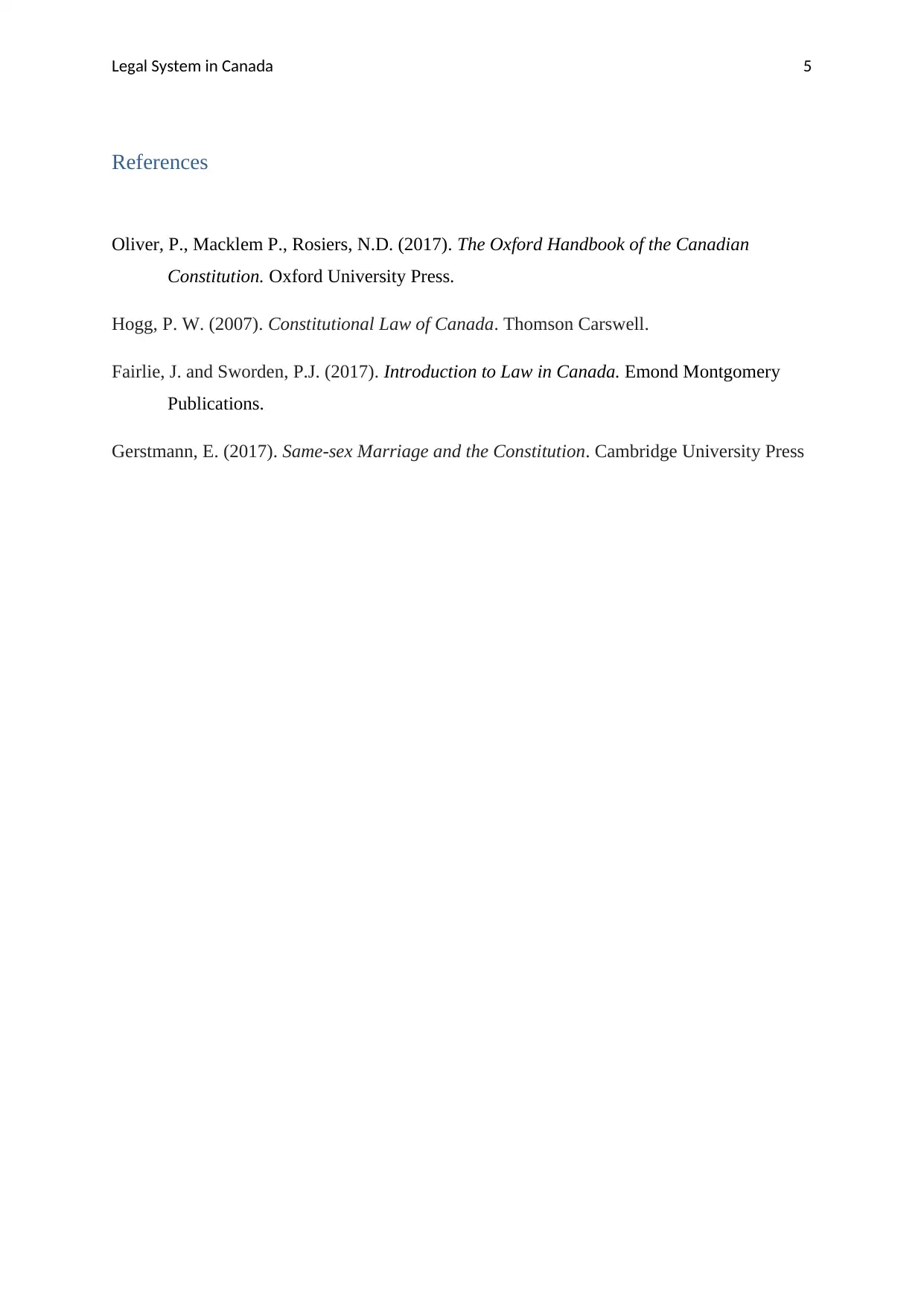
Legal System in Canada 5
References
Oliver, P., Macklem P., Rosiers, N.D. (2017). The Oxford Handbook of the Canadian
Constitution. Oxford University Press.
Hogg, P. W. (2007). Constitutional Law of Canada. Thomson Carswell.
Fairlie, J. and Sworden, P.J. (2017). Introduction to Law in Canada. Emond Montgomery
Publications.
Gerstmann, E. (2017). Same-sex Marriage and the Constitution. Cambridge University Press
References
Oliver, P., Macklem P., Rosiers, N.D. (2017). The Oxford Handbook of the Canadian
Constitution. Oxford University Press.
Hogg, P. W. (2007). Constitutional Law of Canada. Thomson Carswell.
Fairlie, J. and Sworden, P.J. (2017). Introduction to Law in Canada. Emond Montgomery
Publications.
Gerstmann, E. (2017). Same-sex Marriage and the Constitution. Cambridge University Press
⊘ This is a preview!⊘
Do you want full access?
Subscribe today to unlock all pages.

Trusted by 1+ million students worldwide
1 out of 6
Related Documents
Your All-in-One AI-Powered Toolkit for Academic Success.
+13062052269
info@desklib.com
Available 24*7 on WhatsApp / Email
![[object Object]](/_next/static/media/star-bottom.7253800d.svg)
Unlock your academic potential
Copyright © 2020–2025 A2Z Services. All Rights Reserved. Developed and managed by ZUCOL.





